“PSAT practice test is a great way to assess strengths, improve weaknesses, and prepare for the SAT. It’s a good score if it’s in the 75th percentile or higher. Put yourself in real test conditions, analyze your mistakes, and work on your weaknesses. Tutoring services like Ivy Tutors can help you improve your performance and get more scholarships.”
If you plan to study in college, then standard test preparation is necessary. You can use the PSAT practice test to identify your strengths, pinpoint weaknesses, and gain confidence when taking the SAT. Understanding how to approach this test is crucial for students who want to get National Merit recognition or just improve their academic skills.
What Is PSAT and Its Purpose?
The Preliminary SAT (PSAT) is all about analyzing the critical reading, writing, and math skills. It is much like a diagnostic tool for students preparing for the SAT. If students are trying to qualify for the National Merit Scholarship Program (for PSAT/NMSQT takers) this test will help them. It is also a benchmark for college readiness. Unlike the SAT, there isn’t any optional essay in the PSAT and the math section is slightly less advanced. However, best PSAT tips apply directly to future standardized tests.
How to Use a PSAT Practice Test Effectively
Here is how you can use the PSAT practice test effectively.
1. Simulate the Real Test Environment
To get the most from your PSAT practice test, you should simulate the real test environment and scenarios. Start by practicing in a quiet room and under timed conditions. This will help you to experience the real SAT. Opt for the official College Board-approved test material so you will have an idea about the real question format and difficulty.
2. Analyze Mistakes, Not Just Scores
Do not just focus on the raw score only. Analyze the score completely to assess your highs and lows. Sort these errors by category, such as:
- Content-based mistakes include the lack of subject concepts and mastery.
- Test-taking errors include solving in a rush, misleading or careless mistakes.
- Issues such as running out of time or spending too much time on specific questions related to time management errors.
3. Strengthen Weak Areas with Targeted Practice
Taking the practice tests repeatedly will not be effective unless you focus on your specific weaknesses. For example:
- If you find the questions related to geometry difficult, then dedicate time to understanding the geometric principles.
- Practice active reading techniques if reading comprehension takes more time than expected.
What Is a Good PSAT Score?
A PSAT score that is good, usually falls in the top 75th percentile. This means the student did better than about 75% of the people taking this PSAT. The scores change every year and are put in categories by percentiles. This helps students understand their readiness for college and if they can be eligible for the National Merit Scholarship. Below is a reference table for PSAT scores by percentile:
Percentiles assist students in knowing their position among classmates. Green marks reach educational standards, yellow marks are close to these standards, and red marks show places that need enhancement.
PSAT Practice Test Strategies by Section
Each section of the PSAT requires a dedicated strategy. Here is how you can do.
1. Reading Section
Start reading actively. Highlight the key points while reading passages. Focus on the evidence based answers searching to find the direct answer in text. Also, you should learn the time management, Spend approximately 13 minutes per passage.
2. Writing and Language Section
Understand the grammar rules. Learn about the punctuation, verb tense, and subject-verb agreement. Concise phrasing is crucial as the best answer is usually the direct one. Understand the sentence structure errors, where several questions will test how well you know the sentence clarity.
3. Math Section
Start by memorizing the key formulas that the PSAT provides, but knowing them will save you time. Logical estimation is helpful. If you’re stuck, eliminate unreasonable answers. Make sure your calculations are right. Minor arithmetic errors can cost you points.
What is the Format Of the PSAT?
The PSAT/NMSQT (Preliminary SAT/National Merit Scholarship Qualifying Test) has a distinct structure. It includes writing, and math skills. The test consists of two main sections:
| Section | Number of Questions | Time Allotted |
|---|---|---|
| Reading and Writing | 54 questions | 64 minutes |
| Math | 44 questions | 70 minutes |
| Total | 98 questions | 2 hours 14 minutes |
Reading and Writing
- Includes passages covering literature, history, science, and social studies.
- Tests grammar, punctuation, vocabulary, and comprehension.
- Questions require selecting the best word choice, correcting sentence structure, and analyzing texts.
Math
- Divided into algebra, problem-solving, geometry, and data analysis.
- A calculator is allowed for all questions.
- Focuses on real-world application and logical reasoning.
The PSAT has now adapted to a digital format. The scores are scaled on the 320-1520. Understanding the format will help the students plan an effective study schedule.
The Role of Professional Tutoring in PSAT Prep
Though self-study is always a good approach, professional tutoring is beneficial. Tutors from Ivy Tutors can help the students to develop personalized strategies for efficient progress. One-on-one instruction can focus on the specific weaknesses, improving confidence before PSAT test day.

Final Thoughts
A PSAT practice test is not just about scores but about learning as well. By approaching preparation with structure, analysis, and smart strategies, students can maximize their potential. With consistent effort, the PSAT prep test becomes less of a hurdle and more of a stepping stone toward academic success.









